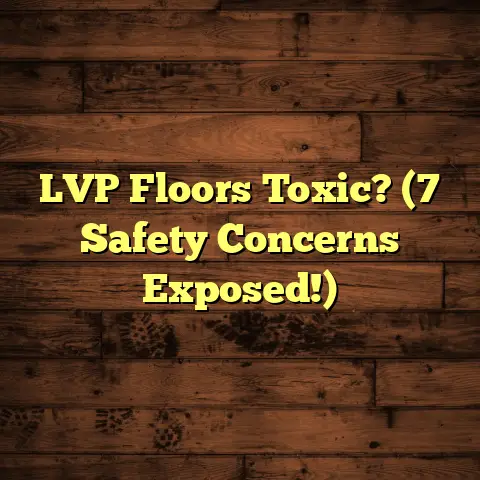Cracked Garage Floor Repairs (6 Fixes Before Winter!)
Let’s face it, a cracked garage floor is more than just an eyesore. It’s a constant reminder of a problem you know you should fix. I get it. I’ve seen countless homeowners kick that can down the road, only to regret it when winter hits. Trust me, that small crack you’re ignoring? Winter’s freeze-thaw cycle will turn it into a gaping chasm that costs a fortune to repair.
The dread of walking into your garage and seeing those cracks worsen with each passing season? The annoyance of trying to keep the garage clean when dust and debris constantly seep up from below? I’ve been there, and I’m here to tell you, you don’t have to live with it!
Section 1: Understanding the Problem – Why Did This Happen To Me?
So, what’s the deal with these darn cracks anyway? It’s rarely just one thing, but more often a perfect storm of factors. As a flooring contractor, I’ve seen it all.
- Temperature Fluctuations: Concrete expands and contracts with temperature changes. In the garage, this is amplified. Hot summers bake the concrete, and freezing winters shrink it. This constant movement puts stress on the slab, leading to cracks.
- Moisture Infiltration: Water is concrete’s worst enemy. When water seeps into cracks and freezes, it expands, widening the cracks even further. This freeze-thaw cycle is a major culprit.
- Poor Installation Practices: Let’s be honest, sometimes it’s just a bad pour. Insufficient concrete thickness, inadequate reinforcement (like rebar or wire mesh), or improper curing can all lead to premature cracking.
- Settling: New homes, in particular, can experience some settling. As the ground beneath the slab compacts, it can cause stress and cracking.
- Heavy Loads: Parking heavy vehicles or storing excessive weight in your garage can also contribute to cracks, especially if the concrete wasn’t designed for it.
According to the American Society of Civil Engineers (ASCE), concrete structures are constantly subjected to environmental stressors that can lead to cracking. In regions with significant temperature variations, like the Midwest, the rate of concrete deterioration is demonstrably higher.
Section 2: The Risks of Ignoring Cracks – Don’t Wait Until It’s Too Late!
“It’s just a crack,” you might be thinking. “It’s not hurting anything.” Wrong! Ignoring those cracks is like ignoring a leaky faucet – it’s only going to get worse and cost you more in the long run.
- Water Damage: Cracks provide a direct path for water to enter your garage. This can lead to dampness, mold growth, and even damage to stored items.
- Structural Integrity: Over time, untreated cracks can compromise the structural integrity of your entire garage floor. This can lead to uneven settling, further cracking, and even the need for a complete replacement.
- Aesthetic Concerns: Let’s face it, cracked garage floors are ugly. They detract from the overall appearance of your home and can even lower its resale value.
- Safety Hazard: Cracks can create tripping hazards, especially for children or the elderly. They can also damage your car’s tires if they’re large enough.
- Winter Weather Woes: Winter is the worst time to ignore cracks. Snow and ice melt, seep into the cracks, and then freeze, expanding and widening the damage. This can lead to significant deterioration over the winter months.
I’ve seen garages where homeowners ignored cracks for years, only to end up with floors so damaged that they needed to be completely torn out and replaced. Trust me, that’s a much bigger headache (and expense) than dealing with the cracks now.
Section 3: Preparing for Repairs – Get Your Ducks in a Row!
Before you grab your tools and dive in, it’s important to prepare properly. This will ensure a successful repair and save you time and frustration.
Necessary Tools and Materials:
- Safety Glasses: Protect your eyes from dust and debris.
- Gloves: Protect your hands from chemicals and rough concrete.
- Wire Brush: For cleaning out cracks.
- Shop Vacuum: For removing dust and debris.
- Chisel and Hammer (Optional): For widening cracks to create a better bonding surface.
- Concrete Cleaner/Degreaser: To remove oil and grease stains.
- Mixing Bucket and Trowel: For mixing and applying patching materials.
- Concrete Epoxy, Resurfacer, or Patch (Depending on the fix you choose): More on this later.
- Sealant (Optional but Recommended): To protect your repaired floor.
- Caulk Gun (If using sealant): For applying sealant.
Safety Precautions:
- Read the Instructions: Always read and follow the manufacturer’s instructions for all products you use.
- Ventilation: Work in a well-ventilated area, especially when using epoxy or sealants.
- Protective Gear: Wear safety glasses, gloves, and a dust mask.
- Keep Children and Pets Away: Keep children and pets away from the work area.
Assessing the Damage:
- How Big Are the Cracks? Hairline cracks (less than 1/8 inch wide) can often be repaired with a simple concrete patch. Larger cracks (1/4 inch or wider) may require epoxy injection or resurfacing.
- How Deep Are the Cracks? Surface cracks are usually easier to repair than deep cracks that extend through the entire slab.
- Are There Any Signs of Structural Damage? If you see significant settling, unevenness, or crumbling concrete, it’s best to consult with a professional.
DIY or Pro?
- DIY: If you’re comfortable with basic home repairs and the cracks are relatively small, you can probably tackle the job yourself.
- Pro: If the cracks are large, deep, or you suspect structural damage, it’s best to hire a professional.
Checklist:
- [ ] Gather all necessary tools and materials.
- [ ] Read and understand the safety precautions.
- [ ] Assess the extent of the damage.
- [ ] Decide whether to DIY or hire a pro.
Section 4: Fix #1: Concrete Epoxy Injection – The Deep Crack Solution
For cracks that are wider than hairline and potentially deep, epoxy injection is a great solution. It essentially “glues” the concrete back together, restoring its strength and preventing water from seeping in.
Step-by-Step Guide:
- Clean the Cracks: Use a wire brush and shop vacuum to thoroughly clean out the cracks. Remove any loose debris, dirt, or oil.
- Install Injection Ports: These are small plastic or metal fittings that you’ll use to inject the epoxy. Space them every 6-12 inches along the crack. You can use epoxy paste to adhere them to the concrete surface.
- Seal the Surface: Use epoxy paste to seal the surface of the crack between the injection ports. This will prevent the epoxy from leaking out during injection.
- Mix the Epoxy: Carefully follow the manufacturer’s instructions for mixing the epoxy. Use the correct ratio of resin to hardener.
- Inject the Epoxy: Using an epoxy injection gun, slowly inject the epoxy into each port until it starts to ooze out of the adjacent port.
- Allow to Cure: Let the epoxy cure according to the manufacturer’s instructions. This usually takes 24-48 hours.
- Remove Ports and Seal: Once the epoxy is cured, remove the injection ports and grind down any excess epoxy paste. You can then apply a concrete sealant to protect the repaired area.
Benefits of Epoxy:
- High Strength: Epoxy is incredibly strong and durable, restoring the structural integrity of the concrete.
- Water Resistance: Epoxy is waterproof, preventing water from seeping into the cracks and causing further damage.
- Permanent Solution: When properly applied, epoxy injection provides a long-lasting repair.
Cost: Expect to pay $3-$8 per linear foot for professional epoxy injection. DIY kits range from $50-$200.
Section 5: Fix #2: Concrete Resurfacing – The Makeover Magic!
If your garage floor has numerous cracks, spalling (surface flaking), or an overall worn-out appearance, concrete resurfacing is a great option. It involves applying a thin layer of cement-based overlay to the entire floor, creating a smooth, new surface.
Step-by-Step Guide:
- Prepare the Surface: Thoroughly clean the existing concrete surface. Remove any oil, grease, dirt, or loose debris. You may need to use a concrete grinder to roughen the surface and create a better bonding surface.
- Apply a Primer: Apply a concrete primer to the surface. This will help the resurfacer adhere properly.
- Mix the Resurfacer: Carefully follow the manufacturer’s instructions for mixing the resurfacer. Use the correct ratio of powder to water.
- Apply the Resurfacer: Pour the resurfacer onto the floor and spread it evenly using a squeegee or trowel. Work in small sections and ensure the resurfacer fills all cracks and imperfections.
- Finish the Surface: Once the resurfacer has been applied, you can use a broom or texture roller to create a decorative finish.
- Cure the Resurfacer: Keep the resurfaced floor moist for several days to allow it to cure properly. Cover it with plastic sheeting or spray it with water regularly.
- Seal the Surface: Apply a concrete sealant to protect the resurfaced floor.
Benefits of Resurfacing:
- Repairs Cracks and Imperfections: Resurfacing fills in cracks, spalling, and other surface imperfections, creating a smooth, new surface.
- Enhances Appearance: Resurfacing can dramatically improve the appearance of your garage floor, making it look brand new.
- Durable and Long-Lasting: When properly applied and sealed, a concrete resurfacer can last for many years.
Cost: Professional concrete resurfacing typically costs $3-$7 per square foot. DIY resurfacing kits cost around $50-$200 per 50lb bag, covering approximately 200 square feet.
Section 6: Fix #3: Using a Concrete Patch – The Quick and Easy Fix
For smaller cracks (less than 1/4 inch wide) and minor surface imperfections, a concrete patch is a quick and easy solution. It’s essentially a premixed mortar that you can apply directly to the damaged area.
Step-by-Step Guide:
- Clean the Crack: Use a wire brush and shop vacuum to thoroughly clean out the crack. Remove any loose debris, dirt, or oil.
- Dampen the Area: Lightly dampen the area around the crack with water. This will help the patch adhere properly.
- Mix the Patch: If using a powder patch, mix it with water according to the manufacturer’s instructions. Premixed patches are ready to use.
- Apply the Patch: Use a trowel to apply the patch to the crack. Press it firmly into the crack and smooth it out to match the surrounding surface.
- Cure the Patch: Keep the patched area moist for several days to allow it to cure properly. Cover it with plastic sheeting or spray it with water regularly.
- Sand Smooth (Optional): Once the patch is cured, you can sand it smooth to blend it with the surrounding surface.
Types of Concrete Patch:
- Acrylic Concrete Patch: Good for hairline cracks and minor surface imperfections.
- Epoxy Concrete Patch: Stronger and more durable than acrylic patch, suitable for larger cracks.
- Vinyl Concrete Patch: Resists shrinking and cracking, ideal for filling larger voids.
Benefits of Using a Concrete Patch:
- Easy to Apply: Concrete patch is very easy to apply, even for beginners.
- Affordable: Concrete patch is relatively inexpensive.
- Quick Drying: Most concrete patches dry quickly, allowing you to use your garage soon after the repair.
Cost: Concrete patch typically costs $10-$30 per container, depending on the type and size.
Section 7: Fix #4: Expansion Joint Replacement – Relieving the Pressure
Expansion joints are intentionally placed gaps in the concrete slab that allow it to expand and contract without cracking. Over time, these joints can become damaged or filled with debris, rendering them ineffective. Replacing damaged expansion joints can alleviate pressure on the concrete and prevent further cracking.
Step-by-Step Guide:
- Remove the Old Joint Material: Use a utility knife or chisel to carefully remove the old expansion joint material.
- Clean the Joint: Use a wire brush and shop vacuum to thoroughly clean out the joint.
- Install New Joint Material: Insert the new expansion joint material into the joint. Make sure it fits snugly and is flush with the surface of the concrete.
- Seal the Joint (Optional): You can seal the joint with a flexible sealant to prevent water from entering.
Identifying Faulty Expansion Joints:
- Cracked or Crumbling Joint Material: The joint material should be flexible and intact. If it’s cracked or crumbling, it needs to be replaced.
- Joint Filled with Debris: If the joint is filled with dirt, rocks, or other debris, it’s not functioning properly.
- Cracks Radiating from the Joint: Cracks radiating from the joint indicate that the joint is not effectively relieving pressure on the concrete.
Benefits of Expansion Joint Replacement:
- Prevents Cracking: By allowing the concrete to expand and contract freely, expansion joints prevent cracking.
- Extends the Life of Your Floor: Properly functioning expansion joints can significantly extend the life of your garage floor.
- Reduces Maintenance: By preventing cracking, expansion joints reduce the need for costly repairs.
Cost: Expansion joint material typically costs $1-$3 per linear foot. Professional installation can range from $5-$10 per linear foot.
Section 8: Fix #5: Sealant Application – The Protective Shield
Sealing your garage floor after making repairs is crucial. A sealant acts as a protective barrier, preventing water, oil, and other contaminants from penetrating the concrete and causing further damage.
Types of Sealants:
- Acrylic Sealers: Affordable and easy to apply, but less durable than other options.
- Epoxy Sealers: Highly durable and resistant to chemicals and abrasion, but can be more expensive.
- Polyurethane Sealers: Offer a good balance of durability and affordability, and are resistant to UV damage.
- Silicone Sealers: Flexible and waterproof, ideal for sealing expansion joints.
Step-by-Step Application Guide:
- Clean the Floor: Thoroughly clean the garage floor. Remove any oil, grease, dirt, or loose debris.
- Etch the Floor (Optional): Etching the floor with a concrete etcher will help the sealant adhere properly. Follow the manufacturer’s instructions carefully.
- Apply the Sealant: Apply the sealant using a roller or sprayer. Apply a thin, even coat.
- Allow to Dry: Let the sealant dry according to the manufacturer’s instructions. This usually takes 24-48 hours.
- Apply a Second Coat (Optional): Applying a second coat of sealant will provide added protection.
Benefits of Sealing:
- Protects Against Moisture: Sealant prevents water from penetrating the concrete, preventing freeze-thaw damage and mold growth.
- Resists Stains: Sealant makes it easier to clean up oil, grease, and other stains.
- Increases Durability: Sealant protects the concrete from abrasion and wear, extending its lifespan.
Cost: Sealant typically costs $20-$50 per gallon, covering approximately 200-400 square feet.
Section 9: Fix #6: Professional Assistance – When to Call in the Cavalry
Sometimes, despite your best efforts, the damage is just too extensive to handle yourself. Knowing when to call in a professional is crucial to avoid making the problem worse.
When to Call a Pro:
- Extensive Cracking: If your garage floor has numerous large cracks, it’s best to consult with a professional.
- Structural Damage: If you see significant settling, unevenness, or crumbling concrete, it’s a sign of structural damage and you should definitely call a pro.
- Unsure of the Cause: If you’re not sure what’s causing the cracks, a professional can diagnose the problem and recommend the best solution.
- Lack of Experience: If you’re not comfortable with DIY repairs, it’s best to hire a professional.
What to Look for in a Contractor:
- Experience: Choose a contractor with experience repairing concrete garage floors.
- License and Insurance: Make sure the contractor is licensed and insured.
- References: Ask for references from previous clients.
- Estimates: Get estimates from multiple contractors before making a decision.
Questions to Ask:
- What is the cause of the cracking?
- What is the best solution for repairing the cracks?
- What is the cost of the repair?
- How long will the repair take?
- Do you offer a warranty on your work?
Value of Professional Repairs:
- Expertise: Professionals have the knowledge and experience to properly diagnose and repair concrete cracks.
- Quality Materials: Professionals use high-quality materials that are designed to last.
- Warranty: Many professionals offer a warranty on their work, giving you peace of mind.
Cost: Professional garage floor repairs can range from a few hundred dollars to several thousand dollars, depending on the extent of the damage and the type of repair.
Conclusion: Taking Action Before Winter Bites!
Don’t let another winter turn your cracked garage floor into a disaster zone! Now is the time to take action. Evaluate your garage floor, assess the damage, and choose the fix that’s right for you. Whether you decide to tackle the job yourself or hire a professional, addressing those cracks now will save you time, money, and headaches in the long run.
Remember, a healthy garage floor not only looks better but also protects your home and your belongings. So, get to work and give your garage floor the TLC it deserves! You’ll thank yourself later.





